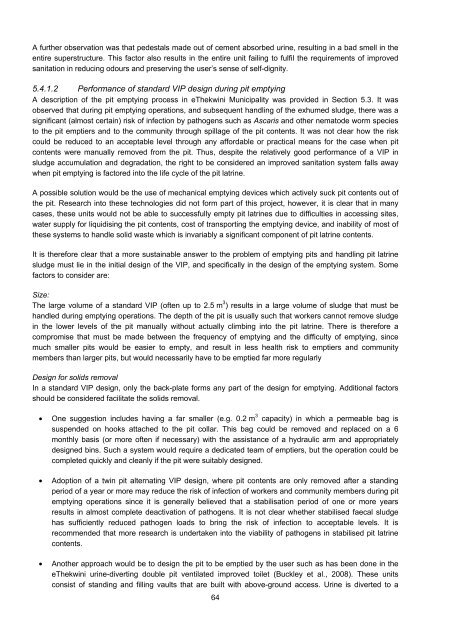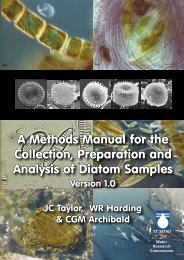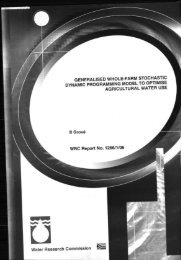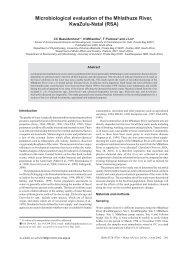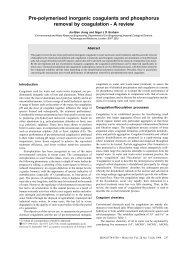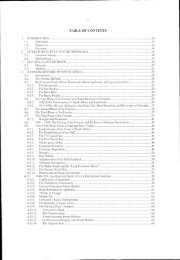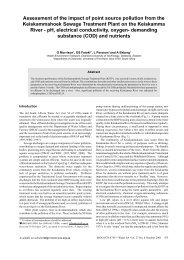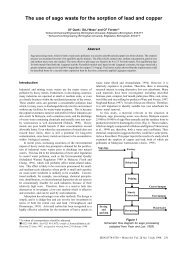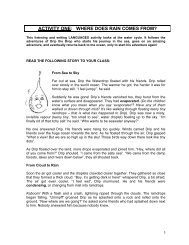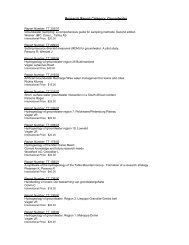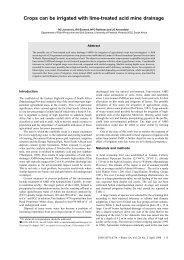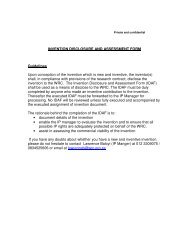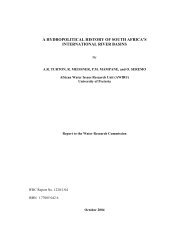and the Efficacy of Pit Latrine Additives - Water Research Commission
and the Efficacy of Pit Latrine Additives - Water Research Commission
and the Efficacy of Pit Latrine Additives - Water Research Commission
- No tags were found...
You also want an ePaper? Increase the reach of your titles
YUMPU automatically turns print PDFs into web optimized ePapers that Google loves.
A fur<strong>the</strong>r observation was that pedestals made out <strong>of</strong> cement absorbed urine, resulting in a bad smell in <strong>the</strong><br />
entire superstructure. This factor also results in <strong>the</strong> entire unit failing to fulfil <strong>the</strong> requirements <strong>of</strong> improved<br />
sanitation in reducing odours <strong>and</strong> preserving <strong>the</strong> user’s sense <strong>of</strong> self-dignity.<br />
5.4.1.2 Performance <strong>of</strong> st<strong>and</strong>ard VIP design during pit emptying<br />
A description <strong>of</strong> <strong>the</strong> pit emptying process in eThekwini Municipality was provided in Section 5.3. It was<br />
observed that during pit emptying operations, <strong>and</strong> subsequent h<strong>and</strong>ling <strong>of</strong> <strong>the</strong> exhumed sludge, <strong>the</strong>re was a<br />
significant (almost certain) risk <strong>of</strong> infection by pathogens such as Ascaris <strong>and</strong> o<strong>the</strong>r nematode worm species<br />
to <strong>the</strong> pit emptiers <strong>and</strong> to <strong>the</strong> community through spillage <strong>of</strong> <strong>the</strong> pit contents. It was not clear how <strong>the</strong> risk<br />
could be reduced to an acceptable level through any affordable or practical means for <strong>the</strong> case when pit<br />
contents were manually removed from <strong>the</strong> pit. Thus, despite <strong>the</strong> relatively good performance <strong>of</strong> a VIP in<br />
sludge accumulation <strong>and</strong> degradation, <strong>the</strong> right to be considered an improved sanitation system falls away<br />
when pit emptying is factored into <strong>the</strong> life cycle <strong>of</strong> <strong>the</strong> pit latrine.<br />
A possible solution would be <strong>the</strong> use <strong>of</strong> mechanical emptying devices which actively suck pit contents out <strong>of</strong><br />
<strong>the</strong> pit. <strong>Research</strong> into <strong>the</strong>se technologies did not form part <strong>of</strong> this project, however, it is clear that in many<br />
cases, <strong>the</strong>se units would not be able to successfully empty pit latrines due to difficulties in accessing sites,<br />
water supply for liquidising <strong>the</strong> pit contents, cost <strong>of</strong> transporting <strong>the</strong> emptying device, <strong>and</strong> inability <strong>of</strong> most <strong>of</strong><br />
<strong>the</strong>se systems to h<strong>and</strong>le solid waste which is invariably a significant component <strong>of</strong> pit latrine contents.<br />
It is <strong>the</strong>refore clear that a more sustainable answer to <strong>the</strong> problem <strong>of</strong> emptying pits <strong>and</strong> h<strong>and</strong>ling pit latrine<br />
sludge must lie in <strong>the</strong> initial design <strong>of</strong> <strong>the</strong> VIP, <strong>and</strong> specifically in <strong>the</strong> design <strong>of</strong> <strong>the</strong> emptying system. Some<br />
factors to consider are:<br />
Size:<br />
The large volume <strong>of</strong> a st<strong>and</strong>ard VIP (<strong>of</strong>ten up to 2.5 m 3 ) results in a large volume <strong>of</strong> sludge that must be<br />
h<strong>and</strong>led during emptying operations. The depth <strong>of</strong> <strong>the</strong> pit is usually such that workers cannot remove sludge<br />
in <strong>the</strong> lower levels <strong>of</strong> <strong>the</strong> pit manually without actually climbing into <strong>the</strong> pit latrine. There is <strong>the</strong>refore a<br />
compromise that must be made between <strong>the</strong> frequency <strong>of</strong> emptying <strong>and</strong> <strong>the</strong> difficulty <strong>of</strong> emptying, since<br />
much smaller pits would be easier to empty, <strong>and</strong> result in less health risk to emptiers <strong>and</strong> community<br />
members than larger pits, but would necessarily have to be emptied far more regularly<br />
Design for solids removal<br />
In a st<strong>and</strong>ard VIP design, only <strong>the</strong> back-plate forms any part <strong>of</strong> <strong>the</strong> design for emptying. Additional factors<br />
should be considered facilitate <strong>the</strong> solids removal.<br />
One suggestion includes having a far smaller (e.g. 0.2 m 3 capacity) in which a permeable bag is<br />
suspended on hooks attached to <strong>the</strong> pit collar. This bag could be removed <strong>and</strong> replaced on a 6<br />
monthly basis (or more <strong>of</strong>ten if necessary) with <strong>the</strong> assistance <strong>of</strong> a hydraulic arm <strong>and</strong> appropriately<br />
designed bins. Such a system would require a dedicated team <strong>of</strong> emptiers, but <strong>the</strong> operation could be<br />
completed quickly <strong>and</strong> cleanly if <strong>the</strong> pit were suitably designed.<br />
<br />
<br />
Adoption <strong>of</strong> a twin pit alternating VIP design, where pit contents are only removed after a st<strong>and</strong>ing<br />
period <strong>of</strong> a year or more may reduce <strong>the</strong> risk <strong>of</strong> infection <strong>of</strong> workers <strong>and</strong> community members during pit<br />
emptying operations since it is generally believed that a stabilisation period <strong>of</strong> one or more years<br />
results in almost complete deactivation <strong>of</strong> pathogens. It is not clear whe<strong>the</strong>r stabilised faecal sludge<br />
has sufficiently reduced pathogen loads to bring <strong>the</strong> risk <strong>of</strong> infection to acceptable levels. It is<br />
recommended that more research is undertaken into <strong>the</strong> viability <strong>of</strong> pathogens in stabilised pit latrine<br />
contents.<br />
Ano<strong>the</strong>r approach would be to design <strong>the</strong> pit to be emptied by <strong>the</strong> user such as has been done in <strong>the</strong><br />
eThekwini urine-diverting double pit ventilated improved toilet (Buckley et al., 2008). These units<br />
consist <strong>of</strong> st<strong>and</strong>ing <strong>and</strong> filling vaults that are built with above-ground access. Urine is diverted to a<br />
64


